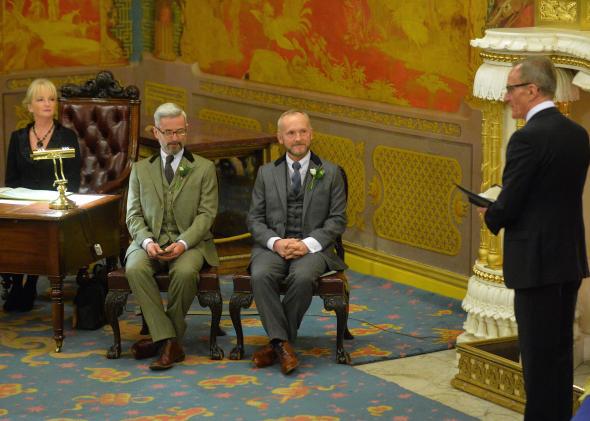This article originally appeared in The Conversation.
It’s exactly a year since the first lesbian and gay couples were married in England and Wales and almost 10 years since civil partnerships were introduced. This fundamental advance in legal recognition has been hailed as a dramatic transformation in the lives of the United Kingdom’s lesbian, gay, and bisexual people.
But what real-life impact has the right to marry or enter a civil partnership actually had on lesbian and gay couples—and why has initial take-up of same-sex marriage been so low?
I’ve been interviewing same-sex couples in the United Kingdom, the United States, and Canada about their experience of marriage and civil partnership, and in all three countries, I’ve been reminded that there’s still a very wide gap between legal and social equality.
The couples I spoke with universally welcomed the package of legal rights and entitlements that come with marriage and civil partnership, especially the idea of next-of-kin and inheritance rights.
Couples with children also said that marriage and civil partnership meant that they felt more recognized as families by having access to a legal status that people around them could relate to and understand. This was also true in public and commercial service settings, for example in health and social care, where a legal status gives a sense of legitimacy and primacy to same-sex partners.
Marriage and civil partnership have also had an impact on family and community life. In particular, weddings and civil partnership ceremonies have provided opportunities for family members as well as friends, neighbors, and work colleagues to acknowledge gay and lesbian relationships.
For couples who took part in the research, this was often a source of great satisfaction, affirming and cementing their status as a couple within their social networks.
But this is only part of the story. For many couples, the wedding or civil partnership ceremony was a more bittersweet occasion, bringing difficult family relationships to a head—and reminding same-sex couples that despite their new legal status, they could not necessarily expect to be treated as equals.
Relatives often had few qualms about refusing to attend a ceremony; one couple’s same-sex wedding was boycotted by the entire family. The idea of a same-sex relationship may have been just about tolerable in some families, but being asked to turn up at the town hall and look like they were enjoying themselves was often too much to stomach.
Negative reactions were a surprisingly regular feature of the research interviews, giving rise to complex emotions, including anger, resentment, and a sense of despair about the prospects for achieving equality.
Dealing with service providers such as local authority registrars, caterers, and jewelers was even more unpredictable. The task of arranging a ceremony or buying wedding rings meant coming out to complete strangers and meeting with anything from effusive acceptance to cold indifference.
For most couples, getting married or forming a civil partnership put them into a variety of new social situations where they were marked out as a same-sex couple. Although for some this was liberating and even exhilarating, for other it provided a reality check on the promises made about the transformative impact of marriage and civil partnerships.
In contrast to couples’ expectations about equality, their experience of getting married or entering a civil partnership often ended up bringing them into contact with a sense of their difference and highlighted the limitations of acceptance. This brought up conflicting emotions about what was supposed to be a profoundly positive milestone in these couples’ lives.
The initial statistics on same-sex marriage in England and Wales indicated a relatively low take-up, with only 1,400 couples marrying during the first three months. That might leave Prime Minister David Cameron wondering why he picked a fight with significant numbers of his own Conservative Party on this apparently symbolic issue.
But the initial figures are unlikely to reflect the long-term demand for same-sex marriage, partly because most same-sex couples who would have married in March 2014 were already in civil partnerships. A clearer picture is likely to emerge later in 2015, when we hear how many couples have decided to convert their civil partnerships to marriages, an option only available since December 2014. The take-up of civil partnerships, after all, was much higher than initial government forecasts.
But whatever the precise numbers, it’s clear that legal recognition for lesbian and gay couples is a policy whose time has come. In Western Europe, Italy is an increasingly isolated exception in not recognizing same-sex couples—providing the context for fashion designers Domenico Dolce and Stefano Gabbana’s ill-advised recent comments dismissing lesbian and gay families, and calling their children “synthetic.”
But the United Kingdom has a long way to go too—and British politicians of all hues need to be more modest about their claims on sexual equality. On paper at least, the United Kingdom is a good place to be gay, lesbian, or bisexual, though same-sex marriage itself is only a distant political project in Northern Ireland.
Far too many lives are still blighted by prejudice and discrimination. As I found in my own research, this holds true for lesbian and gay couples’ experience of marriage and civil partnership as well. Legal reform only takes us so far; it’s usually one of the first steps toward real equality, but it’s certainly not the final one.
So one year on, we should raise a glass to same-sex marriage but not lose sight of the challenges that lie ahead in delivering meaningful, day-to-day equality.
